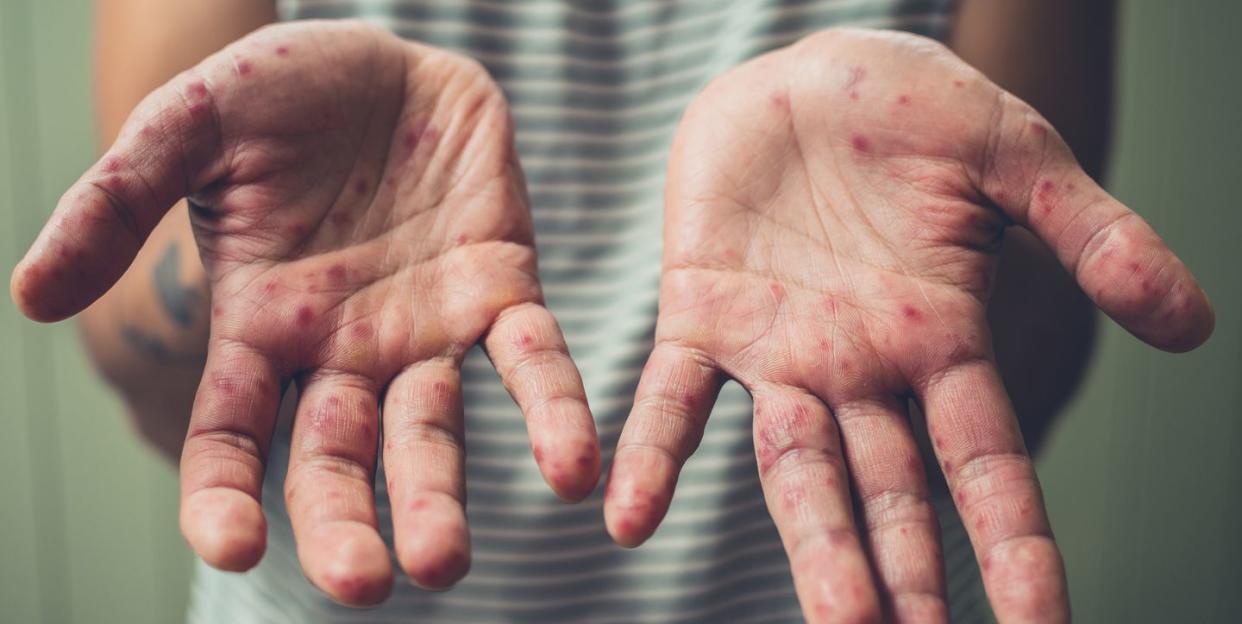What You Need to Know About Hand, Foot, and Mouth Disease

Developing a rash under any circumstance can be concerning and a little annoying. But suddenly getting a rash with painful sores is understandably alarming.
While plenty of health conditions can cause a rash, there’s one in particular that tends to circulate more during the warmer months: hand, foot, and mouth disease.
Not familiar with hand, foot, and mouth disease? It’s not a comfortable illness, but it’s more common than most people realize, says William Schaffner, M.D., an infectious disease specialist at Vanderbilt University School of Medicine. Here’s what you need to know.
What is hand, foot, and mouth disease?
Hand, foot, and mouth disease is a condition that’s caused by viruses in the enterovirus family, according to the Centers for Disease Control and Prevention (CDC). Those include coxsackievirus A16—the most common cause of hand, foot, and mouth disease in the U.S.—coxsackievirus A6, and enterovirus 71.
Hand, foot, and mouth disease spreads through an infected person’s nose and throat secretions (think: saliva or mucus), fluid from blisters or scabs, and poop, the CDC says. People are also the most contagious during the first week that they’re sick.
Hand, foot, and mouth disease is common in the summer and fall in the U.S., the CDC says, although you can get it any time of year. It’s also most commonly spread in schools and daycares.
Stages of hand, foot, and mouth disease
Hand, foot, and mouth disease can cause symptoms in stages, according to the Mayo Clinic. Typically, someone will develop symptoms within three to six days after being exposed. Those can include a fever, followed by a sore throat, poor appetite, and a general feeling of being sick.
One or two days after you develop a fever, you may get painful sores in the front of the mouth or throat, the Mayo Clinic says. “The sores look like little blisters and they ulcerate,” Dr. Schaffner says. “That can be accompanied by a rash which usually manifests as tender little blisters, often on the backs of hands and feet. It can also involve the palms and soles.” The rash on the hands, feet, and butt usually shows up one or two days after the mouth blisters, the Mayo Clinic says.
Overall, though, the symptoms of hand, foot, and mouth disease usually go away after a week, Dr. Schaffner says.
Hand, foot, and mouth disease symptoms
It’s possible to have hand, foot, and mouth disease with no symptoms, but people typically experience the following signs of the illness, according to the Mayo Clinic:
Fever
Sore throat
Feeling unwell
Painful, red, blister-like lesions on the tongue, gums and inside of the cheeks
A red rash on the palms, soles and sometimes the butt
Irritability (in infants and toddlers)
Loss of appetite
Can adults get hand, foot, and mouth disease?
Unfortunately, yes. “Hand, foot, and mouth disease is primarily a disease in children, but adults can get it if they’ve never been exposed before,” says Thomas Russo, M.D., professor and chief of infectious disease at the University at Buffalo in New York. “It’s very infectious.”
Typically, adults who get hand, foot, and mouth disease have close interactions with kids, Dr. Russo says. “They may be daycare workers or parents caring for infected children,” he says. And, because hand, foot, and mouth disease can be spread through secretions and poop, proper hand washing is important to help lower your risk of getting sick, the CDC says.
Hand, foot, and mouth disease treatment
There is no set treatment for hand, foot, and mouth disease. “It’s treated symptomatically,” Dr. Russo says. That includes OTC medication like acetaminophen for the fever and any pain related to mouth sores or blisters, Dr. Schaffner says. The CDC also recommends drinking plenty of liquids to stay hydrated.
Again, hand, foot, and mouth disease typically clears up in a week or so. But, if your symptoms aren’t getting better after 10 days, your symptoms are severe, or your child has a weakened immune system or is younger than six months, the CDC says you’ll want to call your doctor about next steps.
You Might Also Like
